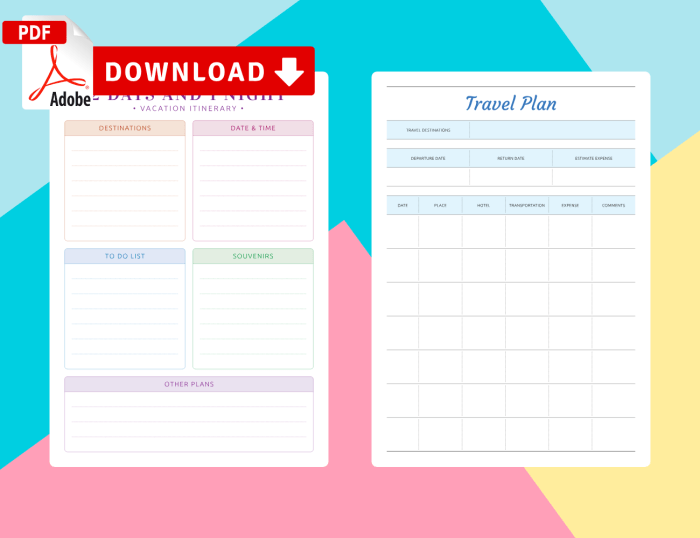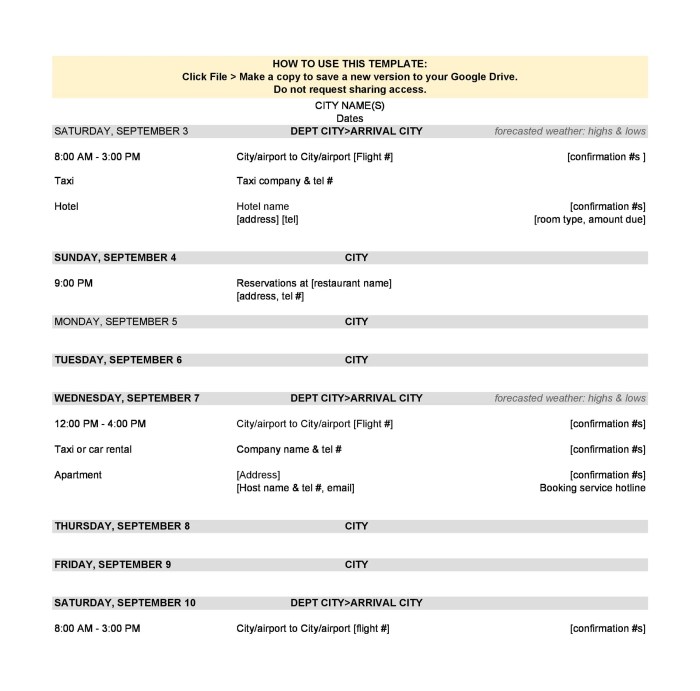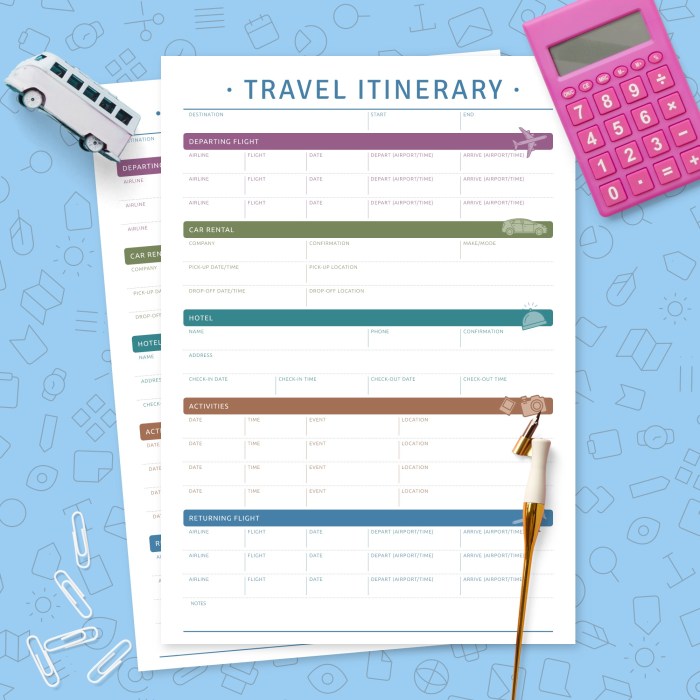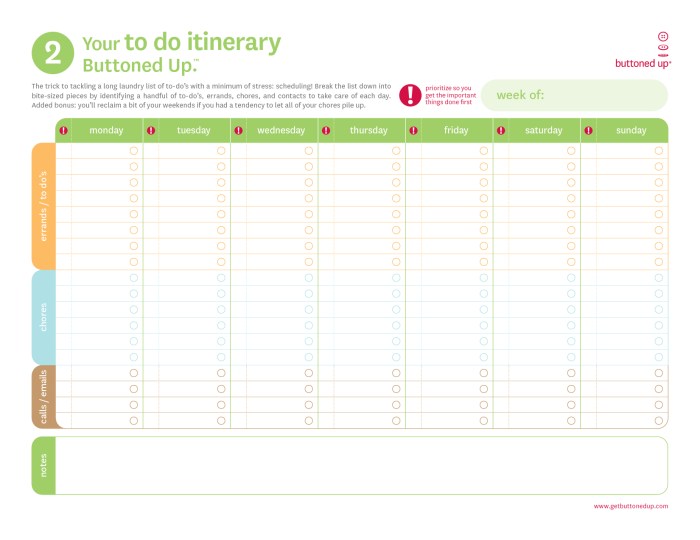Embark on a journey of seamless travel planning with our comprehensive guide to travel itinerary templates. Discover the art of crafting personalized itineraries that cater to your unique needs and preferences, ensuring a stress-free and unforgettable travel experience.
In this detailed exploration, we’ll delve into the essential elements of an itinerary, explore different types tailored to your travel style, and provide step-by-step guidance on creating a customized plan that will make your trip a resounding success.
Comprehensive Travel Itinerary Template

Embark on a seamless travel experience with our meticulously crafted travel itinerary template. Planning a trip can be a daunting task, but with a well-structured itinerary, you can streamline the process, ensuring a stress-free and organized journey.
An itinerary serves as a roadmap for your adventure, outlining every essential detail, from departure and arrival times to accommodation and activities. By adhering to a comprehensive plan, you can maximize your time, optimize your travel expenses, and create lasting memories.
Key Elements of a Travel Itinerary
A comprehensive travel itinerary should include the following key elements:
- Destination Overview:Provide a brief description of your destination, including its location, climate, and key attractions.
- Travel Dates:Specify the exact dates of your trip, including departure and return.
- Transportation Details:Artikel your transportation arrangements, including flight or train schedules, rental car information, and local transportation options.
- Activities and Excursions:Plan your daily activities, including guided tours, museum visits, and outdoor adventures. Consider your interests and the duration of your trip.
- Dining Options:Research and include a list of recommended restaurants, cafes, and local eateries to enhance your culinary experience.
- Budget:Estimate your expenses for accommodation, transportation, activities, and dining, and allocate funds accordingly.
- Packing List:Create a packing list tailored to the climate, activities, and duration of your trip.
- Health and Safety:Include any necessary health precautions, such as vaccinations or medications, as well as safety measures to consider at your destination.
li> Accommodation:List the hotels or guesthouses where you will be staying, along with their addresses and contact information.
Essential Elements of an Itinerary

A comprehensive travel itinerary serves as a roadmap for your journey, ensuring a smooth and organized experience. To create an effective itinerary, it’s crucial to include essential elements that provide a clear overview of your trip.
Here are the key components that should be included:
Dates and Destinations
Clearly define the start and end dates of your trip, as well as the specific destinations you plan to visit. This information provides a framework for planning transportation, accommodation, and activities.
Transportation
Artikel the modes of transportation you will be using, including flights, trains, buses, or rental cars. Specify the departure and arrival times, as well as the duration of each journey.
Accommodation
List the hotels, guesthouses, or other accommodations you have booked. Include the addresses, contact information, and check-in/check-out dates.
A well-planned travel itinerary is the key to a successful trip. With so many things to see and do, it’s important to prioritize your time and plan your itinerary accordingly. Discover the Best Time to Visit Bali: Unlocking Natures Wonders and Cultural Treasures provides valuable information on the best time to visit Bali, ensuring you experience the island’s natural beauty and cultural heritage at their peak.
Activities, Travel itinerary template
Detail the activities you plan to engage in at each destination. This may include sightseeing, tours, cultural experiences, or outdoor adventures. Provide specific times and locations for each activity.
Expenses
Estimate the costs associated with your trip, including transportation, accommodation, activities, food, and other expenses. This information helps you budget effectively and avoid unexpected financial surprises.
Organization
Organize these elements logically and effectively. Use a chronological order, grouping similar activities together. Consider using a spreadsheet, app, or online itinerary planner to keep your itinerary well-structured and easily accessible.
3. Types of Travel Itineraries
Travel itineraries can vary significantly based on several factors, including trip duration, destination type, and travel style. Understanding these different types can help you create an itinerary that perfectly aligns with your preferences and needs.
Trip Duration
- Weekend getaways:Designed for short trips of 2-3 days, these itineraries typically focus on exploring a nearby destination or engaging in specific activities.
- Extended vacations:Longer trips lasting a week or more, allowing for in-depth exploration of a single destination or multiple destinations within a region.
- Multi-destination trips:Involving travel to several different destinations within a single itinerary, these trips offer a diverse range of experiences and cultural immersion.
Destination Type
- City breaks:Itineraries centered around exploring urban destinations, featuring visits to landmarks, museums, and cultural attractions.
- Nature escapes:Focused on outdoor activities and natural attractions, these itineraries often include hiking, camping, and wildlife viewing.
- Beach vacations:Designed for relaxation and sun-soaked experiences, these itineraries revolve around beach activities, water sports, and coastal exploration.
Travel Style
- Independent travel:Itineraries planned and executed by the traveler themselves, allowing for flexibility and customization.
- Guided tours:Organized itineraries led by a tour operator, providing a structured experience with pre-arranged activities and transportation.
- Adventure travel:Itineraries emphasizing physical challenges and outdoor activities, often involving hiking, biking, or kayaking.
4. Creating a Customized Itinerary: Travel Itinerary Template

Tailoring a travel itinerary to suit your specific preferences and requirements is a crucial step in planning a memorable and fulfilling trip. This involves meticulous research, strategic planning, and the effective management of resources.
Follow these steps to create a personalized itinerary:
Research Destinations
Begin by exploring potential destinations that align with your interests. Consider factors such as climate, attractions, cultural experiences, and budget. Utilize online resources, travel blogs, and guidebooks to gather comprehensive information about each destination.
Book Flights and Accommodation
Once you have finalized your destination, secure flights and accommodation in advance to ensure availability and minimize expenses. Compare prices from various airlines and booking platforms to find the best deals. Consider factors such as flight duration, layover times, and airport proximity when selecting flights.
Plan Activities
Determine the activities you wish to experience at each destination. Research attractions, tours, and experiences that cater to your interests. Consider local customs and traditions to ensure a respectful and immersive travel experience.
Manage Expenses
Establish a budget and track expenses throughout your trip. Utilize budgeting apps or spreadsheets to monitor your spending and identify areas where you can save money. Consider factors such as transportation costs, accommodation, meals, and activities.
Tools and Resources
Numerous tools and resources are available to assist in the planning process. Utilize travel planning apps, websites, and guidebooks to gather information, compare prices, and book services. Online forums and social media groups can provide valuable insights and recommendations from fellow travelers.
5. Itinerary Management

Managing and updating your itinerary throughout your trip is crucial for a seamless and stress-free experience. Here’s why:
Tracking expenses allows you to monitor your budget and avoid overspending. Making changes to your itinerary ensures flexibility and accommodates unexpected circumstances. Troubleshooting any unexpected events helps you navigate challenges and find solutions quickly.
When crafting your travel itinerary template, don’t forget to factor in the importance of protecting yourself against unforeseen circumstances. Travelers Insurance: Your Safety Net for Unforeseen Travel Hiccups provides peace of mind and financial assistance in case of unexpected events, ensuring a smooth and worry-free travel experience.
As you plan your itinerary, remember to prioritize your safety and secure the necessary coverage to enhance your travels.
Expense Tracking
- Use a budgeting app or spreadsheet to record expenses daily.
- Keep receipts for all purchases to verify expenses later.
- Categorize expenses to identify areas where you can save money.
Itinerary Adjustments
- Be prepared to adjust your itinerary based on weather conditions, transportation delays, or other unforeseen circumstances.
- Research alternative activities and accommodations in case of changes.
- Inform your travel companions and accommodation providers of any changes promptly.
Troubleshooting
- Stay informed about local news and events that may impact your travel plans.
- Have a backup plan in case of lost luggage or passport issues.
- Contact your travel insurance provider immediately if you experience any emergencies.
Staying Organized and Informed
- Keep your itinerary, travel documents, and other important information in one easily accessible location.
- Use a map app or guidebook to navigate unfamiliar areas.
- Stay connected to the internet for updates and information.
6. Design and Presentation

The visual appeal of an itinerary plays a significant role in enhancing its usability and impact. By employing a visually pleasing design, you can make your itinerary more engaging and easier to follow.
Consider incorporating the following elements to improve the presentation of your itinerary:
Visual Elements
- Use tables to organize information into rows and columns, making it easier to compare and contrast different aspects of the itinerary.
- Employ bullet points to list key details, making the itinerary more scannable and easier to read.
- Incorporate color-coding to differentiate between different sections or types of activities.
- Add images or graphics to enhance visual appeal and provide a better understanding of the destination.
Formatting Elements
- Use clear and concise language, avoiding jargon or technical terms that may not be easily understood.
- Proofread your itinerary carefully for any errors in grammar, spelling, or formatting.
- Consider using a consistent font and font size throughout the itinerary for a professional and cohesive look.
- Provide ample white space to avoid overcrowding the itinerary and make it more visually appealing.
Clarity and Conciseness
- Present the itinerary in a logical order, ensuring a smooth flow of information.
- Highlight important details or key attractions with bold or italicized text.
- Avoid unnecessary details or filler content that may distract from the main purpose of the itinerary.
- Consider using a summary or overview section to provide a quick snapshot of the itinerary’s highlights.
7. Travel Itinerary Templates

Save time and effort by using pre-designed travel itinerary templates. Our curated collection offers a variety of formats to suit different needs, from simple day-by-day plans to comprehensive trip overviews. These templates provide a structured framework to organize your travel details, ensuring a seamless and stress-free journey.
Customizing Templates
Easily adapt these templates to match your unique itinerary. Add or remove sections, adjust the layout, and include personal touches to create a customized plan that reflects your travel style and preferences. The flexibility of these templates allows you to tailor them to suit your specific requirements, whether it’s a weekend getaway or an extended international adventure.
End of Discussion
As you embark on your travels with a well-crafted itinerary in hand, you’ll experience the freedom and confidence that comes with knowing exactly where to go, when to be there, and how to make the most of your precious vacation time.
Remember, a well-planned itinerary is the key to unlocking a truly memorable and fulfilling travel experience.
Essential Questionnaire
What are the benefits of using a travel itinerary template?
Travel itinerary templates provide a structured framework for planning your trip, ensuring you don’t miss any essential details. They help you organize your itinerary logically, track expenses, and make changes as needed, giving you peace of mind and control over your travel experience.
How do I create a customized travel itinerary?
Creating a customized travel itinerary involves researching destinations, booking flights and accommodation, planning activities, and managing expenses. Use online resources, travel guides, and apps to gather information and make informed decisions. Remember to tailor your itinerary to your interests, budget, and travel style.
What are some tips for managing my itinerary during my trip?
Keep your itinerary easily accessible on your phone or laptop. Track expenses using a budgeting app or spreadsheet. Be flexible and make changes as needed, but don’t stray too far from your original plan. Stay organized and informed by checking for updates and notifications related to your flights, accommodation, and activities.